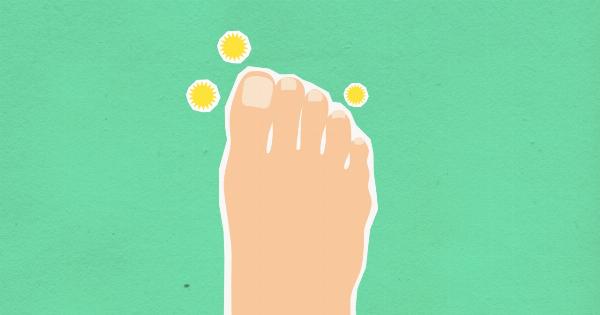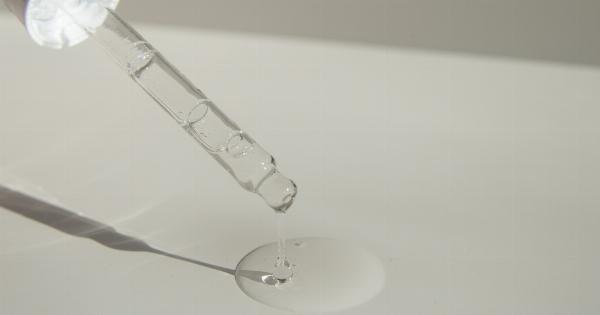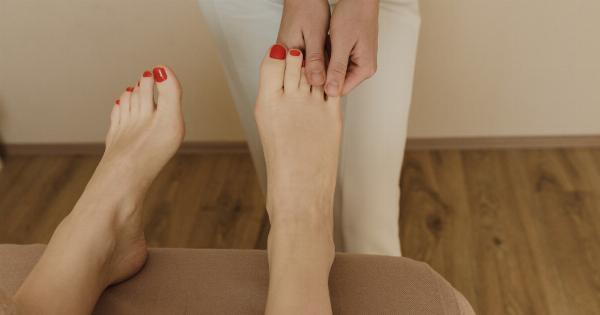Toenail fungus, medically known as onychomycosis, is a common fungal infection that affects the nails, particularly the toenails. It is caused by various types of fungi, such as dermatophytes, yeasts, and molds.
Toenail fungus usually starts as a white or yellow spot under the tip of the toenail and can gradually spread deeper into the nail bed, causing the nail to become discolored, thickened, and distorted. It can also lead to pain, discomfort, and a foul odor. If left untreated, toenail fungus can worsen and even cause permanent damage to the nails.
Causes of Toenail Fungus
Several factors contribute to the development of toenail fungus. These include:.
1. Poor Foot Hygiene
Improper foot hygiene, such as not washing and drying the feet thoroughly, creates a warm and moist environment that encourages fungal growth.
2. Walking Barefoot in Public Areas
Walking barefoot in public places like swimming pools, gyms, and communal showers exposes the feet to various fungi that can cause toenail infections.
3. Wearing Tight or Non-Breathable Footwear
Tight shoes or socks that do not allow proper ventilation can lead to excessive sweating, creating a conducive environment for fungi to thrive.
4. Trauma to the Toe
Injuries to the toenail, such as stubbing, can damage the nail bed and make it more susceptible to fungal infections.
5. Weakened Immune System
Individuals with weakened immune systems, such as those with diabetes, HIV/AIDS, or undergoing immunosuppressive therapy, are more prone to developing toenail fungus.
6. Age and Gender
As we age, the blood circulation and growth rate of nails slow down, making older adults more susceptible to toenail fungus. Men are also more likely to develop toenail fungus compared to women.
Symptoms of Toenail Fungus
The signs and symptoms of toenail fungus may vary depending on the severity of the infection. Common symptoms include:.
1. Thickened Nails
Infected nails often become thicker than usual and may feel uncomfortable, making it difficult to trim or manage them.
2. Nail Discoloration
The infected nail may turn yellow, brown, or even black. In some cases, white patches or spots may also be present.
3. Crumbling or Brittle Nails
The affected nails might become brittle, crumbly, and prone to breaking or splitting easily.
4. Distorted Nail Shape
As the infection progresses, the nail may become increasingly deformed, with an irregular shape and a possibly detached nail plate.
5. Foul Odor
A noticeable, unpleasant smell may emanate from the infected nails due to the buildup of debris and bacteria.
6. Pain or Discomfort
In advanced cases, toenail fungus can cause pain, discomfort, and pressure around the affected toenail, making walking or wearing shoes painful.
Toenail Fungus Treatment
While toenail fungus can be stubborn to treat, several treatment options are available:.
1. Oral Antifungal Medications
Prescription antifungal medications, such as terbinafine or itraconazole, are often the first-line treatment for toenail fungus. They help eliminate the infection by inhibiting the growth of fungi.
2. Topical Antifungal Solutions
Over-the-counter or prescription-strength antifungal nail creams, gels, or solutions can be applied directly to the affected nails to kill the fungus. However, topical treatments may take longer and be less effective for severe infections.
3. Medicated Nail Polish
Antifungal nail polish containing ciclopirox is an alternative treatment option. It is applied to the infected nails and surrounding skin once daily and can help clear the infection over time.
4. Nail Debridement
In cases where the infection is severe or causing significant discomfort, a healthcare professional may perform nail debridement.
This involves physically removing the infected nail material to reduce the fungal load and improve the effectiveness of antifungal treatments.
5. Laser Therapy
Laser treatment is a newer option for toenail fungus. It involves using laser energy to penetrate the nail and kill the fungi. Multiple sessions may be required, and results vary.
6. Surgical Nail Removal
In rare cases where the infection is extremely severe, causing unbearable pain or recurrent infections, surgical nail removal may be considered. This involves permanently removing the infected nail and allowing a healthy nail to regrow.
Preventing Toenail Fungus
While prevention is not always possible, there are measures you can take to reduce the risk of developing toenail fungus:.
1. Practice Proper Foot Hygiene
Wash your feet daily with soap and water, making sure to dry them thoroughly, especially between the toes. Use antifungal powder or spray if necessary.
2. Keep Nails Trimmed
Regularly trim your nails straight across and smooth the edges with a file. Avoid cutting the nails too short or rounding the corners, as this can increase the risk of nail injuries.
3. Wear Breathable Footwear
Choose shoes made from breathable materials, such as leather or canvas, that allow proper airflow. Avoid wearing damp or sweaty shoes for prolonged periods.
4. Protect Feet in Public Areas
If you frequent public areas like swimming pools or locker rooms, wear flip-flops or sandals to minimize direct contact with the floor, which may harbor fungi.
5. Avoid Sharing Personal Items
Do not share towels, nail clippers, socks, or shoes with others, as this can transfer fungal infections.
6. Use Antifungal Sprays or Powders
If you are prone to fungal infections, consider using antifungal sprays or powders in your shoes to help prevent fungal growth.



























